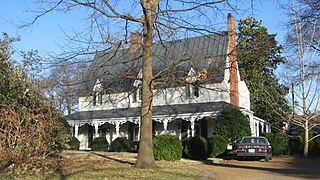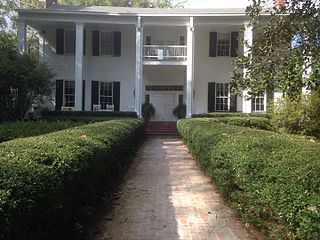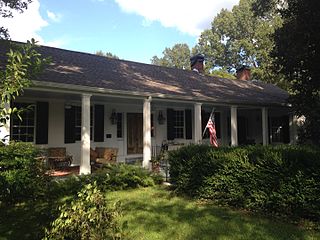
Alexander Jackson Davis, or A. J. Davis, was an American architect, known particularly for his association with the Gothic Revival style.
Minard Lafever (1798–1854) was an American architect of churches and houses in the United States in the early nineteenth century.

Natchez On-Top-of-the-Hill Historic District is a historic district in Natchez, Mississippi that was listed on the National Register of Historic Places in 1979.

The Main Street Historic District is a small residential historic district south of the downtown area of Auburn, Maine. The fourteen houses in the district represent a cross-section of residential development during Auburn's growth between about 1825 and 1925. The district extends along Main Street, from Drummond Street south just past Elm Street, and includes a few houses on Elm and Vine Streets. The district was added to the National Register of Historic Places in 1989.

Madison Historic District in Madison, Georgia is a historic district that was listed in the National Register of Historic Places in 1974. Its boundaries were increased in 1990 and it then encompassed 356 contributing buildings, three other contributing structures, four contributing objects, and three contributing sites.

The U.S. Custom House, also known as the Old Post Office and Custom House, is a historic government building at 423 Canal Street in New Orleans, Louisiana. It was designated a National Historic Landmark, receiving this designation in 1974 and noted for its Egyptian Revival columns. Construction on the building, designed to house multiple federal offices and store goods, began in 1848 and didn't finish until 1881 due to redesigns and the American Civil War. The U.S. Customs offices have been located there since the late 19th century.

The Raymond Historic District is an 80-acre (32 ha) historic district in Raymond, Mississippi that was listed on the National Register of Historic Places in 2007. The listing included 76 contributing buildings, a contributing structure, and a contributing object. Work by the Weldon Brothers is included.

Oakleigh is a historic mansion in Holly Springs, Mississippi, USA.

Walter Place is a historic mansion in Holly Springs, Mississippi, USA. Built in 1860 for pro-Union Harvey Washington Walter, the President of the Mississippi Central Railroad. The mansion was the temporary home of Union General Ulysses Grant and his wife Julia Grant during part of the American Civil War. Later, it was the summer residence of Oscar Johnson, Jr., the co-founder of the International Shoe Company. A combination of Greek Revival and Gothic Revival architectural styles, it was the most expensive house in Mississippi on the market in 2011.

The Neibert-Fisk House, also known as Choctaw, is a historic mansion in Natchez, Mississippi, USA.

Glen Oak is a historic mansion in Nashville, Tennessee, U.S..

The Virden-Patton House is a historic cottage in Jackson, Mississippi.

Sub Rosa is a historic mansion in Pocahontas, Mississippi, U.S.. It was built for John and Margaret Greaves from 1852 to 1854, and it was designed in the Greek Revival architectural style. In 1870, in the aftermath of the American Civil War, the Greaves moved to Los Angeles, California and rented Sub Rosa to Jim Bostick. The house has been listed on the National Register of Historic Places since April 28, 1975.

The Trotter-Byrd House is a historic two-story house in Quitman, Mississippi. It was built for Brigadier General William B. Trotter in the Antebellum era. It is listed on the National Register of Historic Places.

The Mosby-Bennett House is a historic house in Memphis, Tennessee. It was built in the Antebellum era. It is listed on the National Register of Historic Places.

The Stewart-Anderson House is a historic mansion in Tupelo, Mississippi. It was built in 1867. It served as the Tupelo Female Academy and it later became the private residence of state representative and senator W. D. Anderson, who also served as the mayor of Tupelo from 1899 to 1907.

The Wolfe House is a historic cottage in Terry, Mississippi. It was built in 1852 on land owned by the Terry family, and it was designed in the Greek Revival architectural style. It is listed on the National Register of Historic Places.

The Shelton House, also known as the Holliday-Beaufait House, is a historic house in Raymond, Mississippi. It was built in 1830 and designed in the Greek Revival architectural style. It is listed on the National Register of Historic Places.

The Robertson-Yates House is a historic house on a former plantation in Hernando, Mississippi. It was built in 1850 for John Robertson, a settler, and his wife, Susan. It was inherited by their daughter, Annie Eliza Robertson, and her husband, George Yates.

The Amos Deason House is a historic one-story house in Ellisville, Mississippi, U.S.. It was built in 1855–1860, and designed in the Greek Revival architectural style. According to the Hattiesburg American, it is "the oldest house in Jones County." During the American Civil War of 1861–1865, Confederate Major Amos McLemore was assassinated by Newt Knight in the house in 1863. As a result, the house is reportedly haunted, with "unexplained noises, sightings, voices, blood and cold spots and other occurrences." It has been listed on the National Register of Historic Places since July 5, 1984. It was donated to the Daughters of the American Revolution in the 1990s.



















